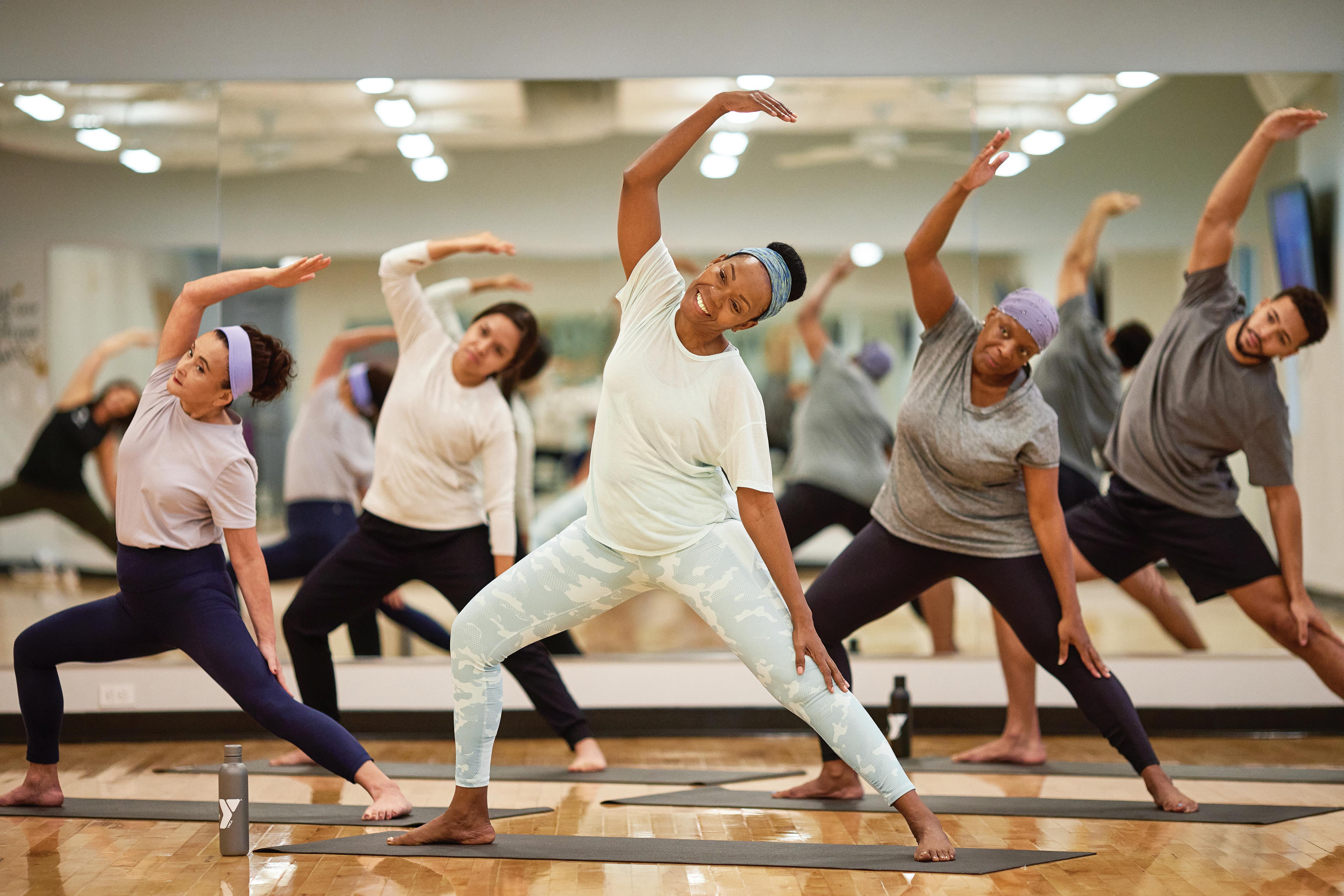From mats to mindset
Finding inner strength at OBX Soundside MMA
By Danielle Puleo
danielle.puleo@ thecoastlandtimes.com
To Laura and David Henry, jiu jitsu is so much more than a martial art.
After seeing their son cultivate a love for the sport, it slowly became a family affair. Now proud owners of OBX Soundside MMA, the Henrys have brought their passion for the art along with the
empowered community of those who practice it to Nags Head. With a wealth of health benefits, both physical and mental, jiu jitsu is all about finding your inner strength, both on and off the mat.
“A lot of women will tell you that they start taking jiu jitsu for self-defense, and a lot of men will say they start to stay in shape,” Laura shared with The Coastland
Times. “But it has a way of just tapping into this version of yourself you never knew existed before.” David and Laura are both instructors and pride themselves on teaching students how to trust themselves and the process, but not be afraid to push the limits of comfortability in order to grow. Jiu jitsu has been known
See Mats, 6B


A black-tie gala benefiting the effort to enhance well-being and longevity in our community.
Saturday, March 22, 2025 | 6 p.m. – Midnight Duck Woods Country Club | Southern Shores, NC
This year’s Painting the Outer Banks Blue Gala will highlight the vibrant flavors, stunning beauty, and cultural treasures of Sardinia, Italy’s Blue Zone! Enjoy an evening inspired by sun-kissed Sardinia, Italy, with live music, dancing, stunning décor, and a Sardinian-inspired culinary journey right here on the Outer Banks.
Sponsorships are available NOW and start at $1,200.
Individual tickets are $300 each and go on sale February 1, 2025.
For more information, scan the QR code on the right, call 252-449-5933, or email Jennifer.Schwartzenberg@outerbankshealth.org.
Just want to dance?
The Late-Night Ticket
9:30 p.m. – Midnight
A limited number of Late-Night Tickets will be sold for $100 each starting March 1, 2025. This ticket will grant access to the gala from 9:30 p.m. until midnight and guests will enjoy the late-night food, beverages, entertainment, and dancing! Get a group of friends together and enjoy the gala sparkle!

Experience a Blue Zone Raffle
Win a trip to Sardinia, Italy!
$100 Raffle Ticket
A limited number of tickets will be sold. Tickets are $100 each and can be purchased by scanning the QR code or by visiting OuterBanksHealth.org/ Gala2025. The raffle winner will be selected at the Painting the Outer Banks Blue Gala. Winner does not need to be present to win. Raffle ticket purchase does not grant admission to the Gala. The Experience a Blue Zone Raffle benefits Outer Banks Health’s efforts to bring well-being and longevity to our community.
Scan for more Gala information
Health and Wellness
Winter wellness at the Corolla Light Sports Club
By Danielle Puleo danielle.puleo@ thecoastlandtimes.com
Who says you can’t swim in the winter? At the Corolla Light Sports Club, just about anything is possible when it comes to staying active, no matter what time of year it is. For their winter season, the sports club has introduced a new class, which is open to the public: aqua aerobics. Known to help eliminate stress to joints and muscles, this cardiovascular workout has a heaping numbers of health benefits for people of all ages. In increasing pulse and breathing rates while strengthening a toning muscles, aqua aerobics is a low impact workout that can help alleviate stress and anxiety, improve flexibility and has been known improve circulation and
lower blood pressure.
The sports club at Corolla Light is offering aqua aerobic classes Mondays, Wednesdays and Fridays from 8 a.m. to 8:45 a.m. Instructor Elaine McCracken is heading the classes – she is a U.S. Masters Swimming certified adult learn-to-swim instructor, certified Masters coach, American Red Cross certified WSI, USAT triathlete and a 300 hour certified yoga instructor. To learn more about pricing, call 219-796-4448. For those looking to stay fit and warm this winter, the sports club offers a variety of classes and activities. Their freshly renovated 36,000 sq. ft. facility is the second largest fitness center on the Outer Banks. Swimmers will enjoy their newly remodeled 25-yard, junior Olympic heated pool and 12-person jetted

spa. General manager Ben Stikeleather shared that private swim lessons are available at the sports center, as well as youth swim programs through a partnership with the Outer
Banks Swim Club.
The facility includes a free-weight room, circuit training room and cardio room, with locker rooms equipped with saunas and full showers. Enjoy tennis,
racquetball and volleyball on their indoor courts. Local tennis pro Tony Willingham offers classes and clinics through the winter at the facility.
Stikeleather said the
sports club is always looking for instructors who are looking for a space to share their services and expertise. Whether it be yoga, step aerobics, painting, cookie decorating, there’s always room for unique ways to stay active and involved at the Corolla Light Sports Club. “We have a lot for those who want a place to exercise, but we want to provide classes for people who are looking to get out and do fun things. We want to bring in activities that the people in our community will enjoy … it’s a really special place.” To learn more about how to become a member of the sports club or sign up for classes, give them a call at 252-453-4565, or stop in for a tour. The facility is open Monday through Sunday from 8 a.m. to 6 p.m. and is located at 1026 Ocean Trail in Corolla.
Spotlight: The Community Care Clinic of Dare
By Danielle Puleo
The Community Care Clinic of Dare (CCCD) is a member of the North Carolina Association of Free and Charitable Clinics, providing healthcare, medication assistance and wellness education to financially strained and uninsured persons in Dare County. They are largely staffed by local experienced medical professionals to address immediate health concerns, manage chronic health conditions and medications, and provide services such as primary care, dental care, mental health care, addiction and patient resources.
CCCD executive director Lyn Jenkins, RN, BSN, understands how essential access to care is and is dedicated to expanding services throughout Dare County. “Integrating medical, dental, mental health, and pharmacy services at CCCD helps our local workers and residents receive whole, patient-centered care for the opportunity to reach their optimal health. CCCD is accepting new patients and expanding access at the satellite clinic in Frisco.”

“It is so humbling to feel that we are making a difference in uninsured patients’ lives at CCCD. We sense the gratitude on a daily basis.”
Their two locations –Nags Head and Frisco –have helped to better serve patients across the county.
CCCD provides primary (non-emergency) medical care, specialty care referrals, prescription medications in the onsite pharmacy, vouchers and prescription assistance programs, health education, inter-agency referrals and immediate referrals for
I am happy to share my knowledge with them. One of my patients told me the reason she comes to see me is because I always explain whatever she needs to know in a way that she can understand exactly what’s going on with her problem. The staff there are supportive and truly generous people.”
Services such as mental health, substance use counseling and addiction treatment are crucial resources which the clinic provides. Patients have the opportunity to connect with licensed clini

relapse of opioid dependence after opioid detox and treatment of alcohol dependence.
CCCD also has an Employers 4 Care program, available to local businesses that want to help employees access health care. CCCD will waive the admin fee and provide primary care services to eligible employees when an employer makes a donation to the clinic. This is an affordable solution for em
appointments began; a partnership with the Outer Banks Restaurant Association was formed; and bi-weekly free food distribution events began in collaboration with the Food Bank of the Albemarle.
Over the past 16 months, CCCD has helped serve 1,577 households with a total of 5,247 neighbors. Volunteer hours amounted to around 800 for 2024. “Food cultures are very different. Working with
community. They really come together to do a good thing, and the volunteers are absolutely wonderful.” The mobile food pantry events are free to members of the community who are experiencing food insecurity. Neighbors can choose from a dynamic variety of foods that are brought in from the food pantry, with options such as healthy choice boxes, diabetic-friendly foods, bakery items, fruits and vegetables, shelf-stable goods and much more. Volunteers from CCCD help set up and organize tions to those who come through. “They really get to know the neighbors and help pick out the food their interested in,” Koksal
For those wanting to learn more about CCCD fer, visit their website at dareclinic.org or call

Health and Wellness
Healthy ways to cope with stress
Stressful experiences are a part of life, and the physiological responses that occur in response to these challenges are natural tools humans developed as survival mechanisms. People learn and grow as they deal with positive stressful occurrences, such as when speaking in public or taking a test. But when stressors cannot be avoided or prove chronic, the body’s response to stress can take a toll on a person’s mental and physical well-being.
The COVID-19 pandemic, inflation, an uptick in strong storms and subsequent weather-related disasters, and global conflicts have proven stressful for people around the world. According to a report from the American Psychological Association titled “Stress in America 2023: A Nation Recovering from Collective Trauma,” the long-term stress sustained since early 2020
has had a significant impact on well-being, as evidenced by an increase in chronic illnesses. The report found people between the ages of 35 and 44 have been particularly affected. Long-term stress poses many health risks, including wear and tear on the immune system and an increase in worry, anxiety and irritability. Some people turn to drugs or alcohol to combat stress, but there are healthy options. The following are better ways to cope with stress.
• Reduce the number of stressors. It is not possible to remove all of the stress of life, but people can try to reduce some forms of stress. Think about sharing some responsibilities or asking for help. If a person is causing you stress, then distance yourself from this person as much as possible. Work is a major source of stress for many people. Finding a new job or cutting back on

tasks could help.
• Get quality sleep. Prioritize sleeping better and longer. Fatigue can exacerbate the ability to deal with even minor stressors, leaving you more irritable and edgy. Most adults
require between seven and nine hours of sleep per night, so adjust your schedule to achieve this.
• Plan for daily exercise. The APA says brisk movement improves sleep and can combat stress.
In one study titled “Relationships between Leisure Time Physical Activity and Perceived Stress,” first published in 1996, researchers found that working adults who engaged in moderate physical
activity had half the perceived stress when compared to working adults who did not participate. A 30-minute session each day can work wonders.
• Engage in pleasurable activities. It’s easy to drop fun things from the schedule when stress is high. But the Cleveland Clinic advises making time for pleasurable things as a means to combatting stress. Laughter and humor can go a long way towards reducing stressful feelings, so a night out at a comedy show or watching a funny movie can help.
• Improve your diet. Well-nourished bodies can handle stressors, illnesses and life in general much easier. Aim for a well-balanced diet that is low in processed foods and sugar. Avoid alcohol, caffeine and nicotine, as each can worsen stress in the long run, according to Sutter Health.
Volunteering is good for your health
Volunteering makes an immeasurable difference in the lives of volunteers and those they help. Many people may be surprised to learn how positive volunteering can be for volunteers. Indeed, studies show that volunteering leads to better physical and mental health, among other benefits.
According to an article published by the American Heart Association and Jeffrey Burr, a professor of gerontology at the University of Massachusetts Boston, “compared to non-volunteers, volunteers have less depression, less anxiety, higher self-esteem, greater happiness, and a greater sense of meaning in life.” Burr and the AHA note the health benefits of volunteering occur among all ages, and a deep look at how volunteer efforts are good for personal health

shows just how profound giving back can be.
• Reduces stress: The Mayo Clinic reports that volunteering reduces stress and increases positive, relaxed feelings by releasing dopamine. When volunteers spend time in service to others, they report feeling a sense of meaning and appreciation, both of which can have stress-reducing effects.
• Lowers depression: Research has shown that volunteering leads to lower rates of depression and anxiety, particularly among people 65 and older.
• Provides a sense of purpose: AmeriCorps reports volunteering can provide a sense of purpose in older adults, which can help replace feelings of inadequacy due to loss of major role
Fast facts about prostate cancer all men should know
Preventive health care encompasses a host of strategies designed to reduce individuals’ risk for conditions and diseases that can adversely affect their quality of life. Routine exercise and a commitment to a nutritious diet are two such strategies, and each can go a long way toward protecting an individual’s long-term health.
Education is another key component of preventive health care. By educating themselves about their own family histories and additional variables that may increase their risk of developing certain conditions, individuals can take steps to mitigate that risk.
The World Health Organization reports that roughly one in five people across the globe develop cancer in their lifetime. Prostate cancer poses a unique threat to men. The WHO notes prostate cancer is the second most commonly occurring cancer in men, and recognition of that threat may compel men to learn more about the disease. Data does not tell the whole story of prostate cancer, but some fast facts about the disease can serve as a springboard to learning more about it and what, if anything, can be done to prevent it.
• The Prostate Cancer Foundation reports that one in eight men will be diagnosed with prostate cancer in his lifetime.

• Rates of prostate cancer are higher among black men. According to the PCF, one in six black men will develop prostate cancer in his lifetime. In addition, black men are more than twice as likely to die from the disease.
• Estimates from the PCF indicate just under 300,000 men will be diagnosed with prostate cancer in 2024, and roughly 35,000 men will die from the disease.
• Men with first-degree relatives who have had prostate cancer may be twice as likely to develop the disease. First-degree relatives include a father, brother or a son. Men are urged to learn their family medical histories so they can identify their own individual risk for prostate cancer.
• The American Cancer Society reports that roughly six in 10 prostate cancers are found in men
older than 65. However, the ACS also notes that the chances of being diagnosed with prostate cancer increase significantly after age 50. And while instances of prostate cancer in men younger than 40 are rare, men 39 and younger can still develop the disease.
• Five-year survival rates for prostate cancer are high when the disease is detected in the localized or regional stages. Localized indicates there is no sign the cancer has spread beyond the prostate, while regional means the cancer has spread to nearby structures or lymph nodes. The five-year survival rate for these stages is greater than 99 percent.
Prostate cancer poses a notable threat to men. Understanding that threat and what can be done to mitigate it is an integral component of preventive health care.
identities, such as wage earner or parent. This sense of purpose can improve life satisfaction and happiness.
• Reduces blood pressure: According to researchers at Carnegie Mellon University, older adults who volunteered for at least 200 hours annually decrease their risk of high blood pressure by 40 percent. This also may lower risk of heart disease and stroke.
• Eliminates feelings of isolation: Volunteers working together link people to others and
their communities. This can help people overcome feelings of isolation, which may come from being new to a community or being a senior and having a smaller social circle.
• Increases happiness: Those who volunteer regularly tend to be happier and more empathetic towards others. Volunteering also instills a sense of pride that can make people happier.
• Keeps the mind active: Individuals who volunteer can improve their cognitive health. That’s because volunteering
engages a person in new skills, requires them to solve problems and keeps them mentally stimulated through various activities.
• Improves physical health: Some volunteer activities will involve physical tasks that can contribute to improved physical health because they constitute moderate exercise.
Volunteering offers a number of benefits that can improve both physical and mental health for those donating their time to help others.


Health and Wellness
Exercise solutions for busy people
Lack of time in the day to get enough done is a common lament. Work, family and social obligations have made many individuals busier than ever before, and that can eat into people’s ability to find time for daily exercise.
The Centers for Disease Control and Prevention says adults need to get at least 150 minutes of moderate-intensity physical activity per week, or 75 minutes of vigorous-intensity activity. For the moderate-intensity recommendation, that boils down to about 21 minutes per day, which is manageable even for the busiest of individuals. To that end, here are some ways busy people can get the exercise they need.
• Wake up early. Starting your day 30 minutes early can allow you
to fit exercise in before a day becomes hectic. Put workout gear out the night before, and when the alarm sounds in the morning, get up and out, whether it’s to head to the gym or go for a morning walk or jog around the neighborhood.
• Use your lunch hour. If you’re not a morning person, use a portion of your lunch break for exercise and then eat your lunch afterwards.
• Take part in high-intensity workouts. High-intensity exercise regimens typically pack exercises into routines that get the heart rate going, but don’t require a lot of time. They may only be 20- to 30-minute sessions, which is doable for most people.
• Recognize exercise comes in many forms.

Many people would be surprised that activities they engage in each day can be classified as exercise. Intense gardening
or lawn care sessions and even home cleaning and improvement projects can work the body. Also, exercise can be built
into regular activities, such as taking the stairs rather than an elevator or parking further away in parking lots to ensure a
Factors that can help overcome a lack of exercise motivation
lengthy walk.
• Consider doing the “Daily 50.” The Daily 50 is an informal exercise routine that can occur anywhere and utilizes body weight to get the job done. Exercises can include 50 squats, 50 lunges, 50 wall pushups, 50 crunches, and/or holding a plank position for 50 seconds. Some also perform 50 knee lifts or hold a wall sit for 50 seconds. These exercises don’t require much time and work most of the major muscle groups.
• Exercise as a family. Turn family leisure time into enjoyable exercise time. Take hikes, go for bike rides or even kayaking trips together to get everyone up and moving. Busy people can make time for exercise with some easy solutions.
Adults undoubtedly recognize the benefits of physical activity. When adults incorporate exercise into their daily routines, they can lower the health risks associated with a sedentary lifestyle, which the World Health Organization reports doubles a person’s risk for cardiovascular disease and diabetes. But even if the benefits of exercise are widely known, many still lack the motivation to get up and go. Lack of time and even fear of the unknown are some of the common reasons people fail to exercise regularly. Others simply can’t get excited about exercise, and that lack of motivation can have longterm negative consequences. Lack of motivation to exercise is such a common hurdle that researchers in China even studied exercise motivation in an effort to identify ways that can help people look
forward to physical activity. That study, published in the journal Frontiers in Psychology in 2024, identified some notable exercise motivations that had a positive impact on participants’ willingness to be physically active. • Fun: The researchers
behind the 2024 study noted that fun had the most profound impact on participants’ motivation to exercise. When individuals found fun ways to be physically active they were most likely to stay the course with an exercise regimen. That’s a
notable distinction, as individuals hesitant to exercise may have a limited view of physical activity. Though exercising in a gym or another type of fitness facility makes it possible to build strength and improve cardiovascular health, additional ways to
exercise can be just as effective and perhaps more fun for those who do not enjoy traditional workouts. Dancing, swimming and cycling are just some of the fun ways to reap the rewards of physical activity.
• Health: Health proved a notable motivation to exercise as well. Researchers noted that individuals who emphasized the health benefits of exercise, including illness prevention and increased life expectancy, were motivated to stay the course with their exercise regimens. Individuals can keep these benefits in mind, particularly if they have a family history of conditions such as diabetes or heart disease, the risks for which are greatly reduced for people who avoid sedentary lifestyles.
• Ability: Researchers noted that ability motivation is another powerful factor in people’s
willingness to maintain an exercise regimen. Ability motivation (ABM) was the third most influential factor identified by the authors behind the 2024 study. When individuals are motivated by a desire to improve their physical performance in a given area, they are more likely to stick with a fitness routine. That’s a notable finding and one individuals can keep in mind as they begin an exercise regimen. Identifying an ability-related goal, whether it be running a marathon or half-marathon or getting better at a sport like pickleball, can provide the motivation people need to commit to an exercise regimen. Lack of exercise motivation is a potentially significant hurdle as people aspire to be more physically active. But identifying some effective motivators can help people stay the course and get on the road to a longer, healthier life.
What young women should know about breast cancer
A prevailing myth concerning breast cancer is that it only affects older women. Various medical organizations and institutions recommend women begin receiving mammograms starting at age 40, which may
is known as early-onset breast cancer. Even adolescents and young adults can get breast cancer. Although young people can get any form of breast cancer, invasive ductal carcinoma and triple-negative breast cancer are
rates of breast cancer among black women, particularly those between the ages of 20 and 29. Black women in this age group were found to have a 53 percent increased risk of breast cancer. The Breast Cancer Research
It is essential for younger women to be in tune with their bodies and learn to recognize any signs that may be indicative of breast cancer. Since annual screenings are not often part of preventative health plans for
breast
• Nipple discharge with or without pain
• Swollen lymph nodes
Any of these signs should be discussed with a primary care physician or a gynecologist.

Health and Wellness
Simple ways to make a diet more nutritious
Nutritious foods are a cornerstone of a healthy lifestyle. The World Health Organization says a healthy diet protects a person against many chronic noncommunicable diseases, such as heart disease, cancer and diabetes. Nutritious foods also help a person get to or maintain a healthy weight, promote stronger bones and teeth, and positively affect long-term mental health. People often wonder how they can improve their daily diets. Here are some ways to make meals more nutritious.
when selecting ingredients for meals. Opt for foods that are low in saturated fats, which tend to contribute to an increase in the amount of cholesterol in the blood. Also, regularly consuming foods and beverages high in sugar increases a person’s risk for obesity and tooth decay, says the National Health Service of the United Kingdom.
• Eat an array of fruits and vegetables. Healthline notes a diet rich in fruits and vegetables has been proven to offer many health benefits. Incorporating a variety of fruits and vegetables into the meals eaten each day will provide fiber, vitamins, minerals and antioxidants. Vegetables also are low in calories and fat, which aligns with diets designed for weight management. Health experts suggest eating greens and other vegetables first so that you fill up and are therefore less likely to eat fewer, less nutritious foods during each meal.
Making smart food choices and watching your portions are hallmarks of many diet plans. While nutritionists often say that losing weight and being healthy involves changing your relationship with food rather than adopting a particular fad diet, even the most carefully designed diets can be derailed when dining out. According to the Centers for Disease Control and Prevention, nearly one-half of adults tried to lose weight within the last 12 months. In 43 markets surveyed within YouGov Global Profiles, 52
• Consume sufficient healthy sources of
protein. Protein is important for managing hunger and sustaining energy and maintaining muscle. Lean sources of protein are best and can include skinless poultry, unprocessed lean meats, seafood and fish, legumes and nuts. Eggs also are excellent sources
of protein. Fish tends to be low in calories for the amount of protein it provides. Try to incorporate oily fish into your culinary repertoire since it’s a source of heart-healthy omega-3 fatty acids.
• Choose whole grain carbohydrates. When selecting breads, cereals,
rices and other carbohydrates, select higher fiber or whole grain varieties. Whole grains contain more fiber than white or refined starches and will help you feel fuller longer.
• Cut down on saturated fats and sugars. Be mindful of food labels
How to dine out while dieting
percent of global consumers are “usually trying to lose weight.”
Once people understand what goes into maintaining healthy diets at home, they can extend those lessons while dining out. The following is a sound approach to making smart food choices when out and about.
• Plan ahead. Look at the menu online and see what the offerings are. This way you can map out what you will be eating without feeling pressured or rushed at the restaurant.
• Don’t arrive hungry.
Eat a small snack before you leave home so you’re not arriving at the restaurant with a growling belly. Choose small, protein-based snacks and whole grains, like some hummus and a slice of whole-wheat toast.
• Consider an appetizer. Dieting involves portion control. It can be easy to eat too much when dining out, as portions seemingly get larger and larger. Instead of choosing an entrée, opt for an appetizer or ask if you can order something from the kids’ menu, as those portions are likely
to be smaller and more in line with the amount of food diners should be eating.
• Fill up on salad or vegetables. Salad and vegetables are nutritionally dense but low in calories for their serving sizes. By eating a salad or making the majority of the meal vegetables, it’s possible to eat fewer calories overall.
• Practice mindful eating. Mindful eating involves paying full attention to the process of eating. Focus on eating rather than conversation, and try to avoid distractions
like watching television while munching, which could compel you to eat too much.
• Make healthy choices. Look for menu items that are smart choices, like lean cuts of meat, grilled or baked foods, broth-based soups, and vinegar-based dressings. Anything that says “fried” or “creamy” likely should be avoided.
• When choosing between a sit-down meal and a buffet line, the sit-down entrée may be the smarter choice. The amount of food on the plate will be finite rather than chafing
• Practice additional smart eating tips. In addition to the foods eaten, there are ways to eat in a more healthy manner. Slow down when eating and savor the foods. Gauge whether you feel full before going back for another portion. Eating foods off a smaller plate can trick the brain into thinking you ate more, a tactic that can help to reduce portion sizes. Cook and prepare more foods at home where you can control ingredients. Eating healthy, nutritious foods is a key to long-term well-being.
dish after chafing dish of tempting options.
• Avoid alcohol. Medline Plus indicates the average drink can have anywhere from 100 to 165 calories per serving. Certain mixed drinks, like a chocolate martini or piña colada, can exceed 500 calories. By skipping the cocktail or wine, it may be possible to trim several hundred calories off a meal. Dining out presents unique obstacles to healthy eating plans. But planning ahead makes it possible to dine out without compromising dieting plans.



Health and Wellness
Tips to make soup more nutritious
Soup is a dish that wears many hats. When the weather becomes chilly, people often turn to soup to warm themselves up from the inside out. Soup, especially ˆwhen paired with a favorite sandwich, can also be a simple and light meal. Soup has been heralded as a remedy as well, a reputation that dates back thousands of years. In the 12th century, Egyptian Jewish physician Moshe ben Maimonides prescribed chicken soup as a treatment for respiratory tract issues. And Penn Medicine suggests eating soup while ill is a good idea because the meal is nourishing, easy to digest and often full of nutritious components. People may wonder what they can do to tweak their favorite soups to make them even more nutritious, as many modern soups have gained a reputation as being sodium-heavy. These ideas can give soup a powerful
boost.
• Use a higher ratio of vegetables in the soup when compared to meats and grains. Vegetables are notoriously high in nutrients that the body needs to stay healthy, including antioxidants and vitamins.
• Make your own soup stock from fresh ingredients. Doing so helps retain control over what goes into the soup, helping to reduce potential additives or other ingredients like sugar and sodium.
• Vary the color of the vegetables. Aim for vegetables of at least three different colors. The colors of the vegetables often correspond to the nutrients and phytochemicals they contain. For example, carrots are high in beta-carotene. Beta-carotene converts into vitamin A, which is necessary for eye health, healthy skin and a strong immune system.
• Replace the cream
in soups with healthier ingredients. Soups that are cream-based tend to be loaded with calories and saturated fat. Instead, use Greek yogurt at the end (to prevent curdling) or even low-fat cottage cheese to amp up the protein content and give the soup a creamy
consistency without the fat. Silken tofu or even a vegetable purée made from potato and cauliflower can add creaminess as well.
• Swap meat for lean proteins in the soup. Lentils, for example, are a plant protein rich in flavor and nutrition. According to UC Davis Health, lentils have about 18 grams of protein per cup and also are high in fiber. Relatively inexpensive, lentils also can help keep meal budgets in check. Alternative legumes also can work in soups, as can seafood or lean poultry.
• Keep ingredients “whole” in the soup. Lean on whole grains, fibrous vegetables, fresh herbs and lean meats to build a well-rounded soup that’s bursting with nutrition.
• Add some turmeric and ginger. If the flavor profile allows, incorporate some fresh turmeric and ginger to the soup. Health magazine says these ingredients are part of the same plant family and have been used in traditional medicine in India and China for centuries. Both are known for reducing inflammation and alleviating symptoms of digestive disease. Experiment with different ingredients to create soups that are not only delicious, but nutritious as well.
• Add texture to the soup. Pumpkin seeds or flax seeds have taste and texture, and can be a healthier option for topping soups over buttery croutons or crackers.
The nutritional value of seafood
Certain types of cuisine tend to inspire a little extra devotion, and seafood is one such food. Seafood is an umbrella term that refers to fish such as salmon and tuna as well as shellfish like shrimp, crab and oysters. That’s a wide range of foods, which underscores the versatility of seafood.
Versatility is one notable attribute of seafood, and diners can keep that in mind as they plan nights out on the town. Another worthy quality of seafood is its
nutritional value, which is perhaps more significant than even the most devoted fish and shellfish lovers recognize.
• Fish is low in saturated fat. The American Heart Association notes that fish is not high in saturated fats. In fact, the AHA recommends eating two servings of fish, particularly fatty fish like salmon, each week. Additional types of fatty fish include bluefin tuna, oysters, mussels, herring, mackerel and anchovies.
• Certain types of fish and seafood can help lower triglyceride levels. Eicosapentaenoic acid (EPA) and docosahexaenoic acid (DHA) are two types of fatty acids found in fish such as mackerel and salmon that are associated with heart health. The Cleveland Clinic notes that EPA and DHA help to lower triglyceride levels, which is beneficial for a variety of reasons. According to the Mayo Clinic, high triglycerides may contribute to a hardening
of the arteries or a thickening of arterial walls, a condition known as arteriosclerosis. Arteriosclerosis is a known risk factor for stroke, heart attack and heart disease.
• Shellfish are high in protein and low in calories. WebMD reports that shellfish are a great
source of lean protein.
That’s a notable benefit, as lean protein is easily digestible and vital for muscle growth and repair. Lean protein sources also can help people feel fuller for longer periods of time, potentially reducing the likelihood that people will overeat.
WebMD notes that a single, three-ounce serving of clams contains 22 grams of protein, which is more than 40 percent of the daily recommended intake for people adhering to a 2,000 calorie diet. That same threeounce serving also contains just 126 calories.

